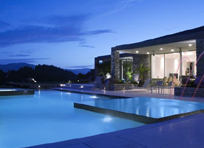communication
We describe them using many terms – as vanishing-edge, infinity-edge, negative-edge, knife-edge, slot-overflow, flooded-deck, gutter or perimeter-overflow pools, among others – but no matter what we call them, all of these watershapes operate on the same basic premise: By moving a sufficient quantity of water from a collection basin or tank to a visible main vessel at a sufficient rate, we can create systems in which
In April 2001, as part of his “Details” column in WaterShapes, David Tisherman argued forcefully for constant, competent on-site supervision of watershaping projects. In his article, entitled “Super Vision,” he noted, “Call it quality control, attention to detail or perfectionism: There’s no
By Mike Farley One of the greatest contrasts I’ve found between watershapers from the pool and spa industry and watershapers with backgrounds in landscape architecture is the way representatives of the two groups handle their portfolios. Landscape architects are taught that
With vast experience in both the residential and commercial markets, Kevin Ruddy is one of the watershaping industry’s foremost experts on the design and construction of indoor swimming pools and their surrounding environments. Here, in this first of two features covering a complicated residential project, he discusses the painstaking process of designing a pool and the systems that integrate it with the surrounding structure. It seems counterintuitive, but indoor swimming pool environments are wholly and entirely distinct from their outdoor cousins. The differences are mostly contained in the fact that, indoors, the designer needs to consider not only the pool and its hydraulic performance, but also the enclosure and the air-handling and dehumidification systems that makes these spaces comfortable and enjoyable for clients and their guests. Through years of designing and installing indoor pools, we at Omega Pool Structures (Toms River, N.J.) have learned – sometimes the hard way – what works and what doesn’t. Now, supported by more than two decades’ experience, we’ve
For more than 10 years now, outdoor rooms have been growing steadily in both popularity and complexity. That’s great, because it enables designers – architects, landscape architects, landscape designers and pool builders alike – to bring interiors outside and provide living spaces where activities previously associated strictly with indoor spaces can move comfortably into the great outdoors. It’s a fantastic way to expand living areas and create useful spaces while also adding entirely new types of experiences to the lives of homeowners. Among this trend’s many implications is that it has challenged landscape lighting designers to think in all-new ways about how we light exterior spaces. For starters, we need to be aware that most homeowners will enjoy these spaces exclusively after dark – and also be conscious of the fact that these environments require much more complicated lighting schemes than classic suburban patios ever did. The differences are so profound that I believe lighting designers need to talk to clients in new ways that


















Elevating Your Game